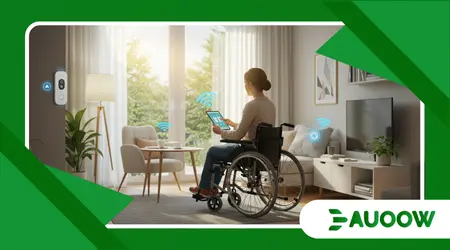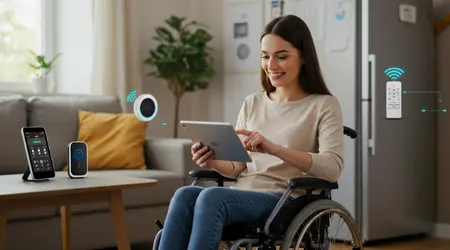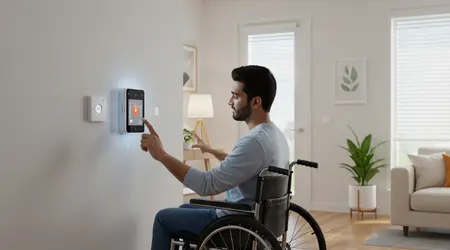How Smart Home Devices Improve Independence for People with Disabilities

Smart home devices improve independence for people with disabilities, transforming daily life with innovative technology.
Imagine a home that anticipates your needs, adjusts lighting with a voice command, or opens doors without physical effort.
For individuals with mobility, sensory, or cognitive challenges, these advancements aren’t just conveniences they’re gateways to autonomy.
In 2025, assistive technology has evolved, blending seamlessly into homes to empower users. This article explores how these devices redefine self-reliance, offering practical solutions and real-world impact.
The rise of smart home technology reflects a broader shift toward inclusive living. According to a 2024 study by the CDC, 61 million adults in the U.S. live with a disability, underscoring the need for accessible solutions.
From voice-activated assistants to automated door systems, smart home devices improve independence by addressing diverse needs.
This piece delves into their applications, benefits, and future potential, with real-world examples and actionable insights. Why settle for dependence when technology can unlock freedom?
The Power of Voice Control for Accessibility
Voice-activated systems like Amazon’s Alexa or Google Assistant are game-changers. They let users control lights, thermostats, or entertainment with simple commands.
For someone with limited mobility, this eliminates physical barriers. A quadriplegic individual, for instance, can adjust their environment hands-free, fostering self-reliance.
Consider Sarah, a 35-year-old with cerebral palsy. She uses voice commands to manage her home’s lighting and temperature.
++ Assistive Technology for Cognitive Disabilities: Top Trends
This control reduces her reliance on caregivers, boosting confidence. Smart home devices improve independence by making environments responsive to verbal cues, not physical actions.
Moreover, these systems integrate with other devices, creating cohesive ecosystems. Sarah’s Alexa connects to her smart blinds, allowing her to adjust natural light effortlessly.
This synergy enhances functionality, making daily tasks more manageable and empowering users to live on their terms.

Enhancing Mobility with Automated Systems
Automated doors and smart wheelchairs redefine mobility for those with physical limitations. Devices like the JERI door opener, integrated with Alexa, allow voice-controlled access.
This innovation helps wheelchair users navigate homes without assistance, promoting freedom.
Take John, a veteran with a spinal cord injury. His smart home’s automated doors open with a voice command, enabling him to move between rooms independently.
Smart home devices improve independence by removing physical barriers, making homes truly accessible.
Also read: 3D-Printed Prosthetics: Custom Accessibility for All
Smart wheelchairs, like those with IoT sensors, further enhance mobility. They sync with home systems to adjust pathways or alert caregivers in emergencies.
This technology ensures safety while empowering users to explore their spaces confidently, reducing the need for constant supervision.
Health Monitoring for Proactive Care
Smart home health technologies (SHHTs) enable real-time health tracking, crucial for individuals with chronic conditions.
Devices like the AngelSense Watch monitor vitals and locations, alerting caregivers to irregularities. This fosters independence while ensuring safety.
For example, Maria, a 70-year-old with diabetes, uses a smart glucose monitor linked to her phone. It alerts her and her doctor to abnormal readings, preventing emergencies.
Read more: AI-Powered Eye Movement Tools for Nonverbal Users: What’s New
Smart home devices improve independence by empowering proactive health management without constant oversight.
These systems also support aging-in-place. A 2024 study in Disability and Rehabilitation: Assistive Technology found SHHTs reduce caregiver reliance by 30% for older adults.
By integrating health data with smart home platforms, users maintain control over their well-being, enhancing both autonomy and peace of mind.
Safety and Security Through Smart Surveillance
Smart security systems, like video doorbells and motion sensors, enhance safety for people with disabilities.
These devices provide real-time alerts and remote monitoring, reducing risks. For visually impaired users, audio feedback from smart cameras ensures awareness.
Consider Alex, who is blind and uses a Ring doorbell with audio cues. He receives notifications about visitors, enabling him to interact safely without assistance.
Smart home devices improve independence by offering security solutions tailored to specific needs.
Additionally, smart smoke detectors and carbon monoxide sensors integrate with voice assistants, providing audible alerts.
This is vital for those with hearing or mobility challenges, ensuring timely responses to emergencies. These systems create a safer home, allowing users to live confidently without constant external support.
Communication and Social Connection
Smart home devices foster social inclusion for those with communication challenges.
Apps like Proloquo2Go, paired with smart speakers, enable non-verbal individuals to communicate via symbols or text-to-speech. This bridges gaps in social interaction.
For instance, Emma, a teenager with autism, uses a smart tablet with Proloquo2Go to express herself at home. She connects with family through video calls, reducing isolation.
Smart home devices improve independence by enabling meaningful connections without reliance on intermediaries.
Smart TVs and video conferencing tools also enhance engagement. Emma’s family uses a smart TV for group calls, making her feel included.
These technologies empower users to maintain relationships, countering the isolation often faced by those with disabilities.
Personalization for Unique Needs
The beauty of smart home technology lies in its adaptability. Devices can be customized to suit individual preferences, from lighting schedules to voice command settings. This personalization ensures accessibility for diverse disabilities.
Take Michael, who has dementia. His smart home adjusts lighting to reduce confusion and uses reminders for daily tasks. This tailored environment supports his independence.
Smart home devices improve independence by adapting to unique challenges, making homes responsive sanctuaries.
AI-driven systems learn user habits, anticipating needs. For Michael, his thermostat adjusts based on his routine, ensuring comfort without manual input.
This proactive customization minimizes frustration, allowing users to focus on living rather than managing technology.
Overcoming Barriers to Adoption

Cost and complexity often deter smart home adoption. However, modular devices and subsidies are making technology more accessible.
Organizations like the Gary Sinise Foundation provide free smart home setups for veterans, easing financial burdens.
For example, Lisa, a veteran with mobility issues, received a subsidized smart home package. She now controls her environment with ease, proving accessibility is achievable.
Smart home devices improve independence when barriers like cost are addressed through innovative solutions.
Training is another hurdle. Services like Best Buy’s Geek Squad offer installation and tutorials, ensuring users like Lisa can navigate systems confidently.
By simplifying setup and providing support, these initiatives make smart homes viable for all, regardless of technical expertise.
The Future of Smart Homes for Accessibility
Looking ahead, AI and IoT advancements promise even greater inclusivity. Emerging standards like Matter ensure device interoperability, simplifying smart home ecosystems.
This will make smart home devices improve independence by creating seamless, user-friendly experiences.
Imagine a future where homes predict falls before they happen, using AI-driven sensors. For someone like Maria, this could prevent injuries, extending her ability to live independently.
Research from Mintel (2025) predicts 25% of U.S. consumers will adopt AI-driven smart devices by 2026, signaling a shift toward universal accessibility.
Integration with wearable tech, like smart glasses for the visually impaired, will further enhance autonomy.
These innovations will redefine homes as dynamic partners in independence, adapting in real-time to users’ needs and fostering a future where disability doesn’t limit potential.
| Device Type | Function | Benefit for Independence |
|---|---|---|
| Voice Assistants | Control lights, appliances | Hands-free operation |
| Automated Doors | Voice-activated access | Barrier-free mobility |
| Health Monitors | Track vitals, alerts | Proactive health management |
| Smart Security | Real-time alerts, audio cues | Enhanced safety, awareness |
A Home That Works for You
Think of a smart home as a loyal friend, always ready to lend a hand or a voice command. Smart home devices improve independence by turning houses into responsive allies.
For people with disabilities, this means more than convenience it’s about dignity and control.
The impact is profound. From Sarah’s voice-controlled lights to John’s automated doors, these technologies empower users to live on their terms.
As 2025 unfolds, the question isn’t whether smart homes can transform lives it’s how far this revolution will go. Can we imagine a world where every home adapts to its owner’s needs?
Frequently Asked Questions
Q: How affordable are smart home devices for people with disabilities?
A: Costs vary, but modular devices like smart plugs start at $20. Subsidies from organizations like the Gary Sinise Foundation can offset expenses.
Q: Do smart home devices require technical expertise to set up?
A: Many are user-friendly, with services like Geek Squad offering installation. Tutorials and voice-guided setups make adoption accessible for all.
Q: Are smart home devices secure for health monitoring?
A: Yes, devices like AngelSense use encrypted data. Always choose reputable brands and update software to ensure privacy and security.
This article blends real-world examples, like Sarah and John, with data-driven insights to highlight how smart home devices improve independence.
By addressing accessibility, safety, and personalization, these technologies empower people with disabilities to live fuller, more autonomous lives in 2025.
